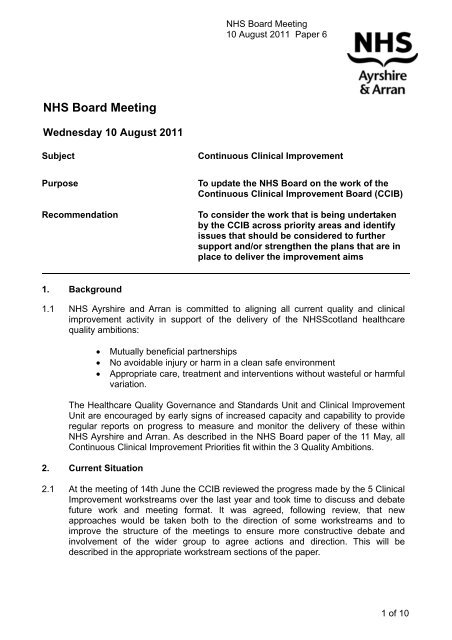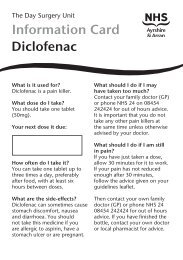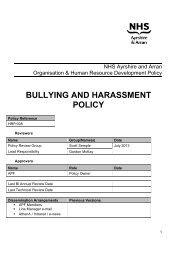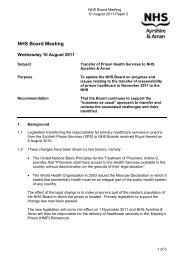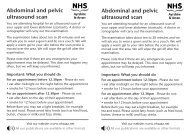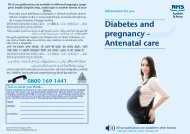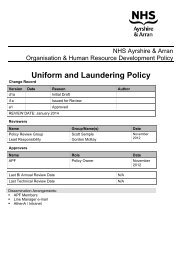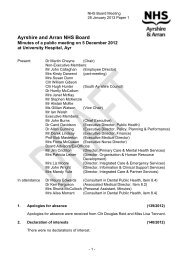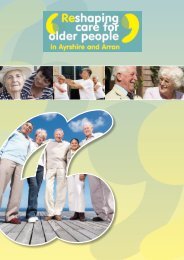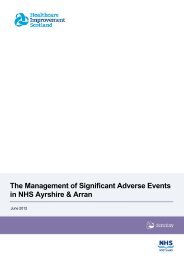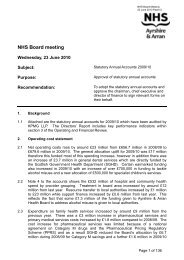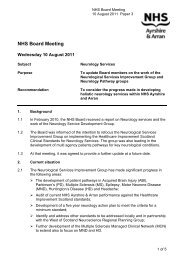Paper 06 - NHS Ayrshire and Arran.
Paper 06 - NHS Ayrshire and Arran.
Paper 06 - NHS Ayrshire and Arran.
You also want an ePaper? Increase the reach of your titles
YUMPU automatically turns print PDFs into web optimized ePapers that Google loves.
<strong>NHS</strong> Board Meeting<br />
10 August 2011 <strong>Paper</strong> 6<br />
<strong>NHS</strong> Board Meeting<br />
Wednesday 10 August 2011<br />
Subject<br />
Continuous Clinical Improvement<br />
Purpose<br />
Recommendation<br />
To update the <strong>NHS</strong> Board on the work of the<br />
Continuous Clinical Improvement Board (CCIB)<br />
To consider the work that is being undertaken<br />
by the CCIB across priority areas <strong>and</strong> identify<br />
issues that should be considered to further<br />
support <strong>and</strong>/or strengthen the plans that are in<br />
place to deliver the improvement aims<br />
1. Background<br />
1.1 <strong>NHS</strong> <strong>Ayrshire</strong> <strong>and</strong> <strong>Arran</strong> is committed to aligning all current quality <strong>and</strong> clinical<br />
improvement activity in support of the delivery of the <strong>NHS</strong>Scotl<strong>and</strong> healthcare<br />
quality ambitions:<br />
• Mutually beneficial partnerships<br />
• No avoidable injury or harm in a clean safe environment<br />
• Appropriate care, treatment <strong>and</strong> interventions without wasteful or harmful<br />
variation.<br />
The Healthcare Quality Governance <strong>and</strong> St<strong>and</strong>ards Unit <strong>and</strong> Clinical Improvement<br />
Unit are encouraged by early signs of increased capacity <strong>and</strong> capability to provide<br />
regular reports on progress to measure <strong>and</strong> monitor the delivery of these within<br />
<strong>NHS</strong> <strong>Ayrshire</strong> <strong>and</strong> <strong>Arran</strong>. As described in the <strong>NHS</strong> Board paper of the 11 May, all<br />
Continuous Clinical Improvement Priorities fit within the 3 Quality Ambitions.<br />
2. Current Situation<br />
2.1 At the meeting of 14th June the CCIB reviewed the progress made by the 5 Clinical<br />
Improvement workstreams over the last year <strong>and</strong> took time to discuss <strong>and</strong> debate<br />
future work <strong>and</strong> meeting format. It was agreed, following review, that new<br />
approaches would be taken both to the direction of some workstreams <strong>and</strong> to<br />
improve the structure of the meetings to ensure more constructive debate <strong>and</strong><br />
involvement of the wider group to agree actions <strong>and</strong> direction. This will be<br />
described in the appropriate workstream sections of the paper.<br />
1 of 10
2.2 The latest adjusted Hospital St<strong>and</strong>ardised Mortality Ratios (HSMR) public release<br />
was on 31st May 2011. (p denotes provisional release).<br />
Jul-Sep 2010<br />
Oct-Dec 2010 (p)<br />
Ayr Hospital 0.91 1.02<br />
Crosshouse Hospital 0.91 1.02<br />
1.40<br />
<strong>NHS</strong> <strong>Ayrshire</strong> & <strong>Arran</strong>: Ayr Hospital.<br />
Hospital St<strong>and</strong>ardised Mortality Ratio (HSMR) - Adjusted<br />
to Oct-Dec 2010p (p denotes provisional)<br />
1.20<br />
1.00<br />
Local Mean = 1.08<br />
0.80<br />
SMR<br />
0.60<br />
0.40<br />
0.20<br />
- - - National Target 15% reduction from Baseline Period = 0.92<br />
0.00<br />
___ Local Target 30% reduction from Baseline Period = 0.76<br />
Baseline Period<br />
Oct-Dec Jan-Mar Apr-Jun Jul-Sep Oct-Dec Jan-Mar Apr-Jun Jul-Sep Oct-Dec Jan-Mar Apr-Jun<br />
20<strong>06</strong> 2007 2007 2007 2007 2008 2008 2008 2008 2009 2009<br />
Jul-Sep<br />
2009<br />
Oct-Dec<br />
2009<br />
Jan-Mar<br />
2010<br />
Apr-Jun<br />
2010<br />
Jul-Sep<br />
2010<br />
Oct-Dec<br />
2010p<br />
Month (quarters)<br />
<strong>NHS</strong> <strong>Ayrshire</strong> & <strong>Arran</strong>: Crosshouse Hospital.<br />
Hospital St<strong>and</strong>ardised Mortality Ratios (HSMR) - Adjusted.<br />
to Oct-Dec 2010p (p denotes provisional)<br />
1.40<br />
1.20<br />
Local Mean = 1.15<br />
1.00<br />
0.80<br />
SMR<br />
0.60<br />
0.40<br />
0.20<br />
Baseline Period<br />
- - - National Target 15% reduction from Baseline Period = 0.98<br />
___ Local Target 30% reduction from Baseline Period = 0.80<br />
0.00<br />
Oct-Dec<br />
20<strong>06</strong><br />
Jan-Mar<br />
2007<br />
Apr-Jun<br />
2007<br />
Jul-Sep<br />
2007<br />
Oct-Dec<br />
2007<br />
Jan-Mar<br />
2008<br />
Apr-Jun<br />
2008<br />
Jul-Sep<br />
2008<br />
Oct-Dec<br />
2008<br />
Jan-Mar<br />
2009<br />
Apr-Jun<br />
2009<br />
Jul-Sep<br />
2009<br />
Oct-Dec<br />
2009<br />
Jan-Mar<br />
2010<br />
Apr-Jun<br />
2010<br />
Jul-Sep<br />
2010<br />
Oct - Dec<br />
2010p<br />
Month (Quarterly)<br />
Data Release Dates: The latest monthly unadjusted mortality data are for April<br />
2011, a value of 4.03% for Ayr Hospital <strong>and</strong> 2.43% for Crosshouse Hospital. The<br />
data for May is currently unavailable due to Patient Management System (PMS)<br />
developments.<br />
Targets: National <strong>and</strong> local targets were calculated from October 20<strong>06</strong> to<br />
December 2007.<br />
National Target (15%) Local Target (30%)<br />
Ayr Hospital 2.9% 2.4%<br />
Crosshouse Hospital 2.5% 2.1%<br />
The national target is a 15% reduction <strong>and</strong> the local target is a 30% reduction for<br />
2012.<br />
2 of 10
5.0<br />
4.5<br />
Baseline Mean = 3.4%<br />
Oct <strong>06</strong> - Dec 07<br />
<strong>NHS</strong> <strong>Ayrshire</strong> & <strong>Arran</strong>: Ayr Hospital.<br />
Unadjusted Inpatient Mortality.<br />
to April 2011<br />
Mean lines change in relation to shifts in run chart<br />
Apparent Seasonal Variation is<br />
currently being reviewed<br />
4.0<br />
3.5<br />
3.0<br />
%<br />
2.5<br />
2.0<br />
1.5<br />
1.0<br />
0.5<br />
Baseline Period<br />
National Target 15% ____<br />
Local Target 30% _ _ _<br />
0.0<br />
Oct-<strong>06</strong><br />
Nov-<strong>06</strong><br />
Dec-<strong>06</strong><br />
Jan-07<br />
Feb-07<br />
Mar-07<br />
Apr-07<br />
May-07<br />
Jun-07<br />
Jul-07<br />
Aug-07<br />
Sep-07<br />
Oct-07<br />
Nov-07<br />
Dec-07<br />
Jan-08<br />
Feb-08<br />
Mar-08<br />
Apr-08<br />
May-08<br />
Jun-08<br />
Jul-08<br />
Aug-08<br />
Sep-08<br />
Oct-08<br />
Nov-08<br />
Dec-08<br />
Jan-09<br />
Feb-09<br />
Mar-09<br />
Apr-09<br />
May-09<br />
Jun-09<br />
Jul-09<br />
Aug-09<br />
Sep-09<br />
Oct-09<br />
Nov-09<br />
Dec-09<br />
Jan-10<br />
Feb-10<br />
Mar-10<br />
Apr-10<br />
May-10<br />
Jun-10<br />
Jul-10<br />
Aug-10<br />
Sep-10<br />
Oct-10<br />
Nov-10<br />
Dec-10<br />
Jan-11<br />
Feb-11<br />
Mar-11<br />
Apr-11<br />
Month<br />
<strong>NHS</strong> <strong>Ayrshire</strong> & <strong>Arran</strong>: Crosshouse Hospital.<br />
Unadjusted Inpatient Mortality<br />
to April 2011.<br />
5<br />
4.5<br />
Baseline Mean = 3%<br />
Oct <strong>06</strong> - Dec 07<br />
Median lines change in relation to shifts in run chart<br />
4<br />
3.5<br />
3<br />
Increased service<br />
pressures<br />
% 2.5<br />
2<br />
1.5<br />
1<br />
0.5<br />
Baseline Period<br />
National Target 15% ____<br />
Local Target 30% _ _ _<br />
Awareness<br />
Training<br />
Back to Basics. ERT<br />
& Coding<br />
Improvements<br />
Implemented<br />
0<br />
Oct-<strong>06</strong><br />
Nov-<strong>06</strong><br />
Dec-<strong>06</strong><br />
Jan-07<br />
Feb-07<br />
Mar-07<br />
Apr-07<br />
May-07<br />
Jun-07<br />
Jul-07<br />
Aug-07<br />
Sep-07<br />
Oct-07<br />
Nov-07<br />
Dec-07<br />
Jan-08<br />
Feb-08<br />
Mar-08<br />
Apr-08<br />
May-08<br />
Jun-08<br />
Jul-08<br />
Aug-08<br />
Sep-08<br />
Oct-08<br />
Nov-08<br />
Dec-08<br />
Jan-09<br />
Feb-09<br />
Mar-09<br />
Apr-09<br />
May-09<br />
Jun-09<br />
Jul-09<br />
Aug-09<br />
Sep-09<br />
Oct-09<br />
Nov-09<br />
Dec-09<br />
Jan-10<br />
Feb-10<br />
Mar-10<br />
Apr-10<br />
May-10<br />
Jun-10<br />
Jul-10<br />
Aug-10<br />
Sep-10<br />
Oct-10<br />
Nov-10<br />
Dec-10<br />
Jan-11<br />
Feb-11<br />
Mar-11<br />
Apr-11<br />
Month<br />
Comment on Results:<br />
Adjusted mortality data continues in a downward change from the baseline period.<br />
This is seen as a -9.2% change at Ayr Hospital <strong>and</strong> a -16.5% change at<br />
Crosshouse Hospital.<br />
Change in HSMR over time in Scotl<strong>and</strong> <strong>and</strong> Ayr <strong>and</strong> Crosshouse Hospitals during the<br />
quarter Oct-Dec 2010 (p).<br />
Area<br />
SMR<br />
Overall trend<br />
at Oct–Dec<br />
Overall<br />
change since<br />
Average change per<br />
Quarter<br />
2010 Oct-Dec 2007<br />
Scotl<strong>and</strong> 0.97 0.94 -6.0% -0.5%<br />
Ayr Hospital 1.02 0.93 -9.2% -0.8%<br />
Crosshouse Hospital 1.02 1.00 -16.5% -1.6%<br />
3 of 10
Unadjusted mortality data for Crosshouse Hospital are showing significant<br />
decreases from July 2009 to November 2009. During this time there was<br />
considerable communication <strong>and</strong> awareness raising in relation to HSMR <strong>and</strong> the<br />
potential causative factors identified during the HSMR review. From February 2010<br />
to November 2010 there is a further reduction relative to the mean rate. This<br />
coincides with the spread of implementation of the ‘Back to Basics’ programme<br />
from December 2009. Seasonal variation is apparent over the winter months due to<br />
severe weather resulting in increased service pressures <strong>and</strong> is being reviewed.<br />
Discharge Letters: A group led by a consultant is looking at improving the time<br />
discharge letters are produced. This would enable coding staff to code more<br />
effectively <strong>and</strong> improve the quality of HSMR data reported externally to Information<br />
Services Division (ISD). Two new software systems have the capability of<br />
supporting this improvement – Patient Management System (PMS) <strong>and</strong> Digital<br />
Dictation System.<br />
Coding: Each month a r<strong>and</strong>om sample of the closed notes of 5 patients who have<br />
died will be reviewed by the Associate Medical Director (AMD) to code the<br />
discharge diagnosis. The results will then be compared to the codes sent to ISD to<br />
assess the level of coding accuracy. As the time to production of discharge letters<br />
improves, it is expected that improved accuracy in coding will be demonstrated.<br />
Back to Basics: This is a programme to support the implementation of a range of<br />
care processes to enhance the delivery of reliable <strong>and</strong> safe care (e.g. structured<br />
formats for communicating clinical information to support care decision making <strong>and</strong><br />
delivery). Improvement interventions are being spread to continue this reduction<br />
<strong>and</strong> progress towards the local target.<br />
Crosshouse Hospital (excluding maternity <strong>and</strong> paediatrics)<br />
ERT Activity per 1000 OBD<br />
ITU Outreach per 1000 OBD ERT Calls per 1000 OBD P.A.R. Assessments per 1000 OBD<br />
26.00<br />
24.00<br />
22.00<br />
20.00<br />
ERTActivity per 1000 OBD<br />
18.00<br />
16.00<br />
14.00<br />
12.00<br />
10.00<br />
8.00<br />
6.00<br />
4.00<br />
2.00<br />
0.00<br />
Aug-10 Sep-10 Oct-10 Nov-10 Dec-10 Jan-11 Feb-11 Mar-11 Apr-11 May-11<br />
Month<br />
Emergency Response Team (ERT): The ERT has now been in place for 10<br />
months. The graph above demonstrates steady numbers in relation to ERT calls to<br />
provide assistance with patients who have deteriorated suddenly. The numbers of<br />
patient at risk assessments carried out as a result of ward trawls by the team have<br />
reduced. The team however identify an increase in informal calls <strong>and</strong> speedy<br />
escalation to the ward medical team when a patient shows signs of deterioration.<br />
The Advanced Nurse Practitioners (ANPs) have commenced collecting data in<br />
relation to the informal calls <strong>and</strong> interactions <strong>and</strong> this will be included in the overall<br />
measurement as soon as a reliable process is agreed for collating the data.<br />
4 of 10
Patient Case Note Review<br />
Patients with a predicted probability of death
• The quality of nursing record keeping<br />
• Assessment of falls risks <strong>and</strong> implementation of appropriate actions to<br />
reduce risk<br />
• Implementation of the Guideline for the Clinical Management of patients with<br />
actual <strong>and</strong> suspected head injury No. 90.<br />
Improvement actions to date have included:<br />
• Sharing learning from Significant Adverse Event Reviews (SAERs) within<br />
the area, <strong>and</strong> at Charge Nurse <strong>and</strong> Clinical Governance meetings<br />
• Education of Charge Nurses re consequence scoring escalation <strong>and</strong><br />
procedures<br />
• Reviewing nursing management of patients at risk of falls – deployment of<br />
staff, safety briefs, risk assessment <strong>and</strong> record keeping<br />
• Falls Clinical Quality Indicator implemented <strong>and</strong> consistently > 95%<br />
• Audit of nursing records demonstrates improvement<br />
It has been agreed to provide dedicated clinical improvement practitioner resource<br />
to support the required improvement interventions.<br />
Work has also been undertaken in relation to pressure ulcers with the aim of<br />
reducing pressure ulcers within the test areas (Ward 2a <strong>and</strong> Station 16) by 50% by<br />
December 2011. Similar challenges to those mentioned above for falls have been<br />
identified including; identification, classification <strong>and</strong> recording of pressure ulcers,<br />
the use of Datix to report pressure ulcers, the development of a care bundle <strong>and</strong><br />
documentation, record keeping <strong>and</strong> guidelines.<br />
2A Days between PU incidence<br />
Time betw een events<br />
120<br />
100<br />
80<br />
60<br />
40<br />
20<br />
0<br />
3/1/11<br />
3/23/11<br />
3/28/11<br />
4/5/11<br />
5/11/11<br />
Date<br />
5/31/11<br />
100%<br />
80%<br />
60%<br />
40%<br />
20%<br />
0%<br />
4/15/11<br />
2A Compliance with SSKIN bundle<br />
4/20/11<br />
4/27/11<br />
5/17/11<br />
5/27/11<br />
Date<br />
5/31/11<br />
100%<br />
90%<br />
80%<br />
70%<br />
60%<br />
50%<br />
40%<br />
30%<br />
20%<br />
10%<br />
0%<br />
3/2/11<br />
Stn 16 Compliance with SSKIN bundle<br />
3/10/11<br />
3/31/11<br />
4/8/11<br />
4/12/11<br />
4/27/11<br />
5/6/11<br />
Date<br />
5/12/11<br />
5/17/11<br />
number of days<br />
200<br />
150<br />
100<br />
50<br />
0<br />
Stn 16 Days between PU incidence<br />
45<br />
25<br />
0<br />
11/1/10<br />
11/26/10<br />
1/9/11<br />
date<br />
5/31/11<br />
142<br />
Experience to date in the test wards has shown that the most valuable measure is<br />
the number of days between development of a new pressure ulcer on the ward.<br />
Compliance of the application of monitoring the pressure ulcer care bundle is also<br />
being measured.<br />
6 of 10
(SSKIN; this care bundle ensures screening is undertaken, the surface the patient<br />
is laying on is appropriate <strong>and</strong> not creating problems, the patient is kept moving to<br />
reduce areas of maximum pressure, incontinence is managed <strong>and</strong> skin is kept dry,<br />
<strong>and</strong> that the patient is nutritionally stable.)<br />
Whilst the data above in relation to days between pressure ulcer incidences looks<br />
encouraging, it does not pick up patients who are admitted to the ward who already<br />
have a pressure ulcer or where they got it. Further work needs to be undertaken in<br />
relation to the measurement system in order to identify this <strong>and</strong> track patients to<br />
ensure appropriate care management is commenced <strong>and</strong> continued.<br />
Through the endeavour of both workstreams it has been identified that falls <strong>and</strong><br />
pressure ulcers require similar essential elements of care to formulate care<br />
bundles. It has also been identified that nutritional care elements are also essential<br />
for both care bundles. The co-dependency of essential elements of care makes it<br />
difficult to deliver elements of care in the isolated way that is currently happening<br />
<strong>and</strong> makes care delivery cumbersome for staff involved.<br />
2.4 Medicines Management<br />
The graphs above demonstrate medicines reconciliation (MR) for the test sites in<br />
Ayr <strong>and</strong> Crosshouse. (MR is the process of obtaining an up to date <strong>and</strong> accurate<br />
medication list that has been compared to the most recently available information<br />
<strong>and</strong> has documented any discrepancies, changes, deletions <strong>and</strong> additions) The<br />
benefits of MR include;<br />
• reducing prescribing errors<br />
• reducing hospital admissions <strong>and</strong> re-admissions due to harm from medicines<br />
• reducing the number of missed doses <strong>and</strong> improving the quality <strong>and</strong> timeliness<br />
of information available to clinicians, thereby leading to improved therapeutic<br />
outcomes<br />
• Increasing patient involvement in their own care promoting better concordance<br />
<strong>and</strong> reducing waste<br />
7 of 10
The results in the test site at Crosshouse have improved dramatically as the test<br />
site is enriched due to the fact that there is a pharmacist in this area who<br />
undertakes the reconciliation of medicines. The reconciliation process at Ayr<br />
continues to be unreliable with signs of deterioration. Clinical leads are working<br />
hard to identify issues, develop solutions <strong>and</strong> have identified that the Emergency<br />
Care Summary (ECS) may present part of the solution.<br />
The ECS is a summary of basic information about the patients health which might<br />
be important when the patient needs urgent medical care when the General<br />
Practitioner’s (GPs) surgery is closed, or when the patient goes to an Accident <strong>and</strong><br />
Emergency (A&E) department. The summary provides information regarding<br />
current medication that has been prescribed by a patient’s GP <strong>and</strong> can act as one<br />
of the two sources required for MR.<br />
Currently the trainee doctors do not all access the ECS, making MR much more<br />
difficult. The reasons for the lack of access by trainees are; ECS access is given no<br />
priority in relation to medical induction <strong>and</strong> there is a subsequent poor uptake of<br />
ECS training which must be undertaken to use the system; junior medical staff are<br />
a rotational work force. They require to be trained <strong>and</strong> given passwords for ECS<br />
when they enter employment with <strong>NHS</strong> <strong>Ayrshire</strong> <strong>and</strong> <strong>Arran</strong>. This is irrespective of<br />
previous training <strong>and</strong> access in other Scottish Health Boards.<br />
2.5 Safety Culture Work<br />
Staff working with Maternity Services were asked to complete the Pascal Metrics<br />
Safety Attitudes Questionnaire (SAQ). The SAQ is a psychometrically validated<br />
tool for measuring patient safety culture using seven dimensions; teamwork<br />
climate; safety climate; job satisfaction; stress recognition; working conditions;<br />
perceptions of senior management <strong>and</strong> perception of local management.<br />
In line with Pascal Metrics methodology, maternity staff were grouped into nine<br />
distinct cohorts of staff who worked together in a work setting The safety culture<br />
survey has now been completed for the maternity unit with a response rate of 62%.<br />
Initial feedback has been delivered to over 200 staff by Michael Leonard of Pascal<br />
Metrics.<br />
Senior clinical leaders from the organisation have participated in a 2 day<br />
conference with Pascal Metrics <strong>and</strong> senior leaders throughout the United Kingdom<br />
to better underst<strong>and</strong> the survey, how to brief staff of the results for their area <strong>and</strong><br />
how to identify safety issues <strong>and</strong> develop improvement plans.<br />
3. Proposal<br />
3.1 To continue with the ‘suite’ of actions outlined in this report <strong>and</strong> maintain<br />
momentum <strong>and</strong> clinical engagement in relation to reduction of HSMR. Progress will<br />
continue to be monitored <strong>and</strong> the data will be used to identify when the<br />
interventions made have resulted in improvement <strong>and</strong> to allow improvement work<br />
to be refocused as required to meet the target of a decrease of 30% by 2012. The<br />
HSMR Steering Groups <strong>and</strong> CCIB will to continue to determine actions to support<br />
the meeting of these targets.<br />
8 of 10
3.2 Following lengthy discussion <strong>and</strong> debate it has been agreed that the workstreams<br />
should be merged to develop an essential elements of care bundle that would<br />
address the falls, pressure ulcers <strong>and</strong> nutritional care. The approach favoured to<br />
take this forward would be an intentional rounding approach using a checklist to<br />
deliver all elements of essential care, reduce risk <strong>and</strong> improve outcomes. Further<br />
work will be undertaken <strong>and</strong> a proposal brought to the August meeting of CCIB for<br />
approval.<br />
3.3 To address the issue of MR through the use of ECS, CCIB reached the following<br />
agreement: when a patient presents to the Emergency Department (ED) as<br />
unscheduled patient an additional question would be added to the list of questions<br />
currently asked by the ED clerk “Do you consent for access to your ECS?” (N.B.<br />
This is a routine question for all patients phoning <strong>NHS</strong> 24).<br />
The triage nurse would then print the ECS along with the ED yellow card (if access<br />
had been permitted).<br />
The medicine information included in the ECS would be relevant for ED staff<br />
assessing <strong>and</strong> treating all patients irrespective of whether a patient is discharged<br />
from the ED or admitted to a ward. If a patient is to be admitted to a ward the ECS<br />
would be transferred with the patient by ED staff along with the patient’s clinical<br />
notes.<br />
This would ensure a st<strong>and</strong>ardised process is in place for all unscheduled patients<br />
admitted to wards irrespective of speciality.<br />
3.4 Clinical <strong>and</strong> managerial staff from maternity services have agreed that a Maternity<br />
Quality Improvement Team (MQIT) will be convened to oversee the culture work.<br />
Detailed results of the survey will be delivered to the individual clinical cohorts<br />
within the maternity service by the Assistant Directors Clinical Improvement <strong>and</strong><br />
Healthcare Quality <strong>and</strong> the Organisation Development Lead. At the end of the<br />
process each of the clinical cohorts will identify their own clinical improvement<br />
interventions <strong>and</strong> a Clinical Improvement Practitioner will be assigned to support<br />
the teams to take the work forward. The timescale as recommended by Pascal<br />
Metric for the debriefing <strong>and</strong> improvement intervention planning will be completed<br />
by 27 December <strong>and</strong> whilst this may appear prolonged, it is imperative that the<br />
work is progressed by gaining the maximum involvement of the cohorts. It has also<br />
been agreed that a capacity building event will be held in the autumn to provide the<br />
MQIT <strong>and</strong> key clinical cohort leaders with key skills in the science of patient safety<br />
<strong>and</strong> quality improvement.<br />
The MQIT will report progress to the group chaired by the Executive Nurse Director<br />
to progress actions arising from the Royal College of Obstetricians &<br />
Gynaecologists (RCOG) report.<br />
Following intensive review of the safety culture requirements for maternity services,<br />
careful consideration will be given to the roll out of the programme across other<br />
clinical areas. This will be debated at the CCIB meeting on 16 August 2011.<br />
4. Engagement <strong>and</strong> consultation on development of the proposal<br />
4.1 The content of this report is a reflection of discussions between staff in the<br />
Healthcare Quality, Governance <strong>and</strong> St<strong>and</strong>ards Unit <strong>and</strong> Clinical Improvement<br />
Unit. It also reflects discussion within the CCIB.<br />
9 of 10
5. Resource implications <strong>and</strong> identified source of funding<br />
5.1 All of the proposals within this paper will be delivered within existing resources,<br />
taking account of the need to deliver cash releasing efficiency savings.<br />
6. Risk assessment <strong>and</strong> mitigation<br />
6.1 Systems, processes <strong>and</strong> structures are being implemented to ensure that all known<br />
risks to the delivery of the quality ambitions are being mitigated.<br />
7. Impact assessment <strong>and</strong> consequential changes proposed to mitigate adverse<br />
impacts identified<br />
7.1 This is an internal document that does not require impact assessment.<br />
8. Conclusion<br />
8.1 Development of a revised CCIB meeting structure <strong>and</strong> format will facilitate wider<br />
discussion, debate <strong>and</strong> action planning.<br />
8.2 The Adjusted HSMR data continues to demonstrate a downward change from the<br />
baseline period - a -9.2% change at Ayr Hospital <strong>and</strong> a -16.5% change at<br />
Crosshouse Hospital. Given the ongoing reduction, the changes to practice will<br />
continue to be monitored <strong>and</strong> the development of the HSMR group at Ayr Hospital<br />
Site will facilitate the implementation of the suite of actions within this care setting.<br />
8.3 A proposal will be tabled at the August CCIB meeting to describe the merger of the<br />
falls, pressure care <strong>and</strong> nutritional care workstreams into essential elements to<br />
provide a checklist to support a care bundle approach.<br />
8.4 The MR results in Crosshouse have improved due to the input of a Pharmacist,<br />
however Ayr results continue to be unreliable. It is anticipated that the roll out of the<br />
ECS will address some of the reliability issues. Improved access to ECS by junior<br />
doctors will also form part of the solution.<br />
8.5 A MQIT will be convened to oversee the Patient Safety Culture work. Detailed<br />
results will be provided to individual cohorts in order to identify their clinical<br />
improvement activity. Following review of this work roll out of the programme will<br />
be considered for other clinical areas.<br />
8.6 This report identifies that progress continues to be made across the CCIB<br />
workstreams. Clinical leads continue to be supported. Capacity <strong>and</strong> capability<br />
building for Clinical Improvement <strong>and</strong> Healthcare Quality is planned for the autumn<br />
<strong>and</strong> will aid future progress <strong>and</strong> reduce person dependence in some areas.<br />
Robert Masterton, Executive Medical Director<br />
Fiona McQueen, Executive Nurse Director<br />
[Craig White, Diane Murray]<br />
19 July 2011<br />
10 of 10


